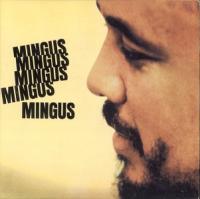Perhaps this is the best review that you have been made here, true he is the most popular singer in the sixties. - Reputation Management
Mingus Still Fires On All Cylinders in '63
Perhaps this 1963 session isn’t peak Mingus, but it’s still unpredictable, volatile Mingus, leading two different 10 piece ensembles recorded in January and September of 1963. Side one’s group includes Eric Dolphy, Booker Ervin and Jaki Bayard, among others, and Mingus’s arrangements let them take flight beginning with a rumbling “II B.S.” (two bullshit), which probably became the template for every second rate jazz composer scoring for 1960’s television crime shows. The track absolutely smokes, fueled by Britt Woodman’s angry trombone blats and Jaki Bayard’s controlled keyboard pounding. Try not to get charged up when this track is playing.
“I X Love,” dedicated to an “ex” love that Mingus “Xed out,” according to Nat Hentoff’s liner notes, is a reworking of an older Mingus piece called “Nouroog.” It’s a typically slinky, sensuous Mingus composition, redolent with film-noir overtones and arranged with profusions of multi-colored horn bursts that seem to splatter onto plate glass windows and then slowly drip down to the pavement below. Urban ‘60’s New York pours from the veins of the track and indeed from the whole record. There’s a restlessness about most of these tracks, buttressed by an almost overpowering anger, but always overlaid with sensuousness.
“Celia,” a three dimensional portrait of a Mingus ex-wife, shows her to be seductive, turbulent and at times, shall we say, strong-willed. The track ends with an absolutely gorgeous sax solo, I assume by Ervin. The side ends with Ellington’s famous “Mood Indigo,” highlighting Mingus’s center stage tugging bass, which skips across the melody line with rubber souled shoes. The body of the arrangement is for the trio of Mingus, Bayard and drummer Walter Perkins, and their turn stops time until the entrance of the horns which restate the theme and take the tune home. End of a ballsy side!
Side two begins with “Better Get Hit in Yo’ Soul,” a gospel-like rave in 6/8 that the liner notes say has no particular religious significance. There’s lots of whoopin’ and hollerin’ and celebratory hand clapping and a finale that meanders into rock and roll. While the liner notes claim it is part of the September session wherein long time Mingus collaborator Dannie Richmond takes over on drums, while Charlie Mariano replaces Dolphy on alto and Jay Berliner adds guitar, that doesn’t happen until the second track on side two, “Goodbye Pork Pie Hat,” Mingus’s classic bluesy tribute to Lester Young, called “Theme For Lester Young” here. Finally there’s “Hora Decubitus,” a twisting, turning, high spirited chaser that highlights the trumpets on the right channel and the reeds on the left.
Speaking of left/right, this is a somewhat better spread than you’ll find on many of the early Impulses, which were really two track recordings meant to be folded down to mono. Engineer Bob Simpson is well known among RCA “Living Stereo” enthusiasts. Unfortunately the recording venue is not listed. The wide left/right spread between the reeds (left) and brass (right) helps to highlight Mingus’s arranging skills, and with Mingus’s bass and the drums filling in the center, the stereo picture is more than acceptable compared to some of the hard “left/right” Impulse “stereo” issues.
As between the original Rudy Van Gelder Impulse and Speakers Corner’s reissue, the original has more “air,” (probably artificial reverb), somewhat greater transparency and more sparkling transients (the tape was fresh), but the reissue, cut in Germany at the Berliner mastering facility at Universal, Hanover from an analog copy of the master tape has its own warm charms and plenty of detail and imaging three dimensionality. It’s true to the spirit of the original, though the EQ is a bit bumped up in the bass—not a bad thing, really given Mingus’s instrument. Better a touch warm than icy cold. The recording is not an “audiophile” spectacular, but Bob Simpson does a better job than some Impulse engineers in capturing natural instrumental timbres, thus effectively communicating Mingus’s brilliance as an arranger. A rewarding set that I’ve enjoyed for more than 20 years. You may still find the MCA 1995 180g reissue somewhere on line for less, but while it’s an honest attempt, it falls short timbrally. You get what you pay for, so either go with an original, or pick up the Speakers Corner. Be sure to search for interview with mastering engineer Willem Makkee
- Log in or register to post comments





